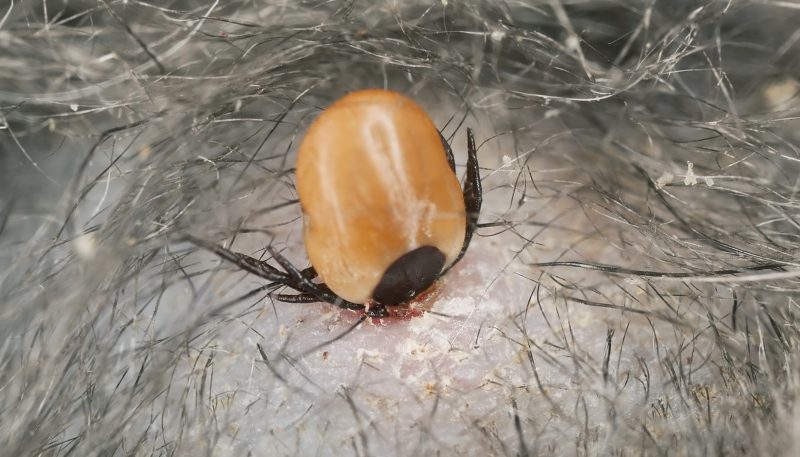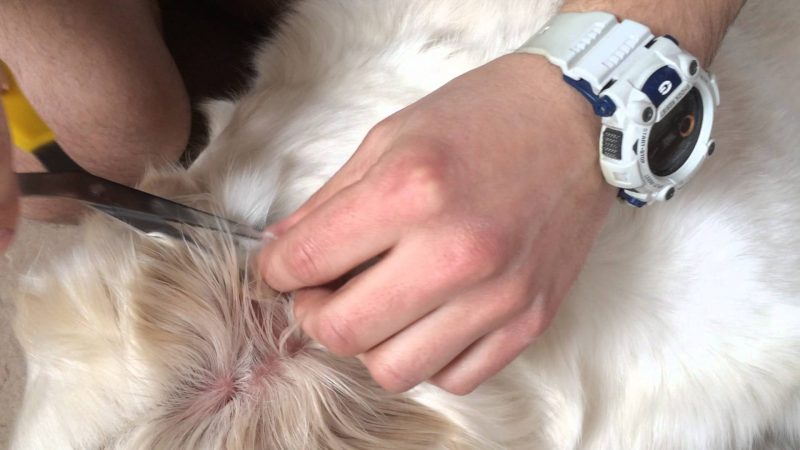Each owner of a fourth friend is obliged to imagine how to get a tick from a dog. Such knowledge will be especially relevant in the warm season, since ticks are most active in the spring and summer.
Material Content:
The danger of a tick for a dog
It should be noted right away that mites, even in large numbers, are unable to bleed the dog.
Their danger lies elsewhere - parasites are carriers of pathogens of very serious dangerous ailments.
For example, pyroplasmosis. This is a blood disease that can quickly lead an animal to death as a result of rapidly developing kidney failure.
Ticks also carry Lyme disease. It is dangerous for animals and for people. If such an ailment begins to develop in a pregnant dog, it will cause the death of the offspring in the womb.
In addition, canine parasites can be carriers of dangerous pathogens. These are ehrlichiosis, bartonellosis and some others that affect blood cells.
Dogs of different ages and breeds can get sick with these ailments. Interestingly, the infection occurs not only through a bite, but also as a result of accidental ingestion of the vector of infection.
There are also ticks that settle on the skin of dogs for a long time. They do not tolerate dangerous infections, but they cannot be called harmless either. The main source of their nutrition is the skin cells of the pet. As a result, parasites cause the development of various dermatological diseases in the dog.
Symptoms of an animal picking a tick
If the dog has a tick under the skin, it will not be easy to notice the problem to its owner. The list of symptoms will depend on how much the dog has become ill.
But there are common signs suggesting that something is wrong with the pet:
- Decreased habitual activity of the dog. The dog ceases to be playful, does not ask for a walk, does not run and does not jump.
- Decreased / complete loss of appetite. The animal refuses even his favorite treats.
- On the 3rd - 5th day, more disturbing signs usually characteristic of a specific ailment usually appear.
With pyroplasmosis, in addition to general weakness, the dog experiences rapid weight loss, fever, urine becomes dark in color. In addition, jaundice is manifested, some organs (for example, liver and spleen) increase in size. It is necessary to begin the correct treatment as soon as possible, otherwise the death of the dog can not be avoided.
After infection with ehrlichiosis and bartonellosis, the pet develops a strong fever, which deprives him of strength. Joints can also become inflamed, pulmonary edema, anemia can occur.
Home removal methods
Removing a tick from a wound is quite difficult. After all, the dog will be pulled out of pain. Relieve her condition will help lidocaine spray.
Next, you need to direct the lamp to the problem area, calm the dog and push it to the sofa. If the bite is long, the hair should be cut off and the surrounding hair should be smoothed with oil.
The parasite extraction algorithm:
- To spread a tick body with a liquid which does not pass air. It can be nail polish or a special tool from a veterinary pharmacy against parasites. A large drop of oil, in which the tick must be placed, is suitable for this purpose.
- Leave the parasite in this form for about half an hour and observe it. If the tick has not yet had time to drink blood, then it will fall off by itself. The swollen parasite will simply weaken, it will extract the proboscis and paws from the skin.
- It happens that the tick does not "go away" on its own. Then you need to add a new layer of oil and wait another quarter hour.
- Again, not "retreating"? In this case, you will need to use tweezers. First of all - get all the limbs of the parasite.
- Next - grab his body and carefully remove the tick from the skin. In this case, it should be twisted in different directions, as, for example, when loosening a tooth.
It is important not to crush the parasite. It must be removed in a jar or test tube and taken to a laboratory. If the tick turns out to be a carrier of infection, the owner will be able to start treating his pet at the earliest stage of infection.
What absolutely can not be done by detecting a tick
It is very important to correctly remove the tick so as not to harm the dog. In the process, you can’t categorically touch an insect with your bare hands. All work must be done with gloves. Otherwise, the host himself may become infected with a dangerous virus.
There is no need to pull and pull the tick strongly from the wound, because its limbs and head easily come off. Danger and crush the insect. Otherwise, his secrets can get into the wound and cause serious inflammation in the animal.
What to do after removing the parasite
After removing the dangerous “guest”, it is imperative to sanitize the problem area of the skin. If the tick head still remains in the wound and you cannot get it yourself, it is better to go to the veterinarian right away. It is forbidden to make a deep cut in the skin yourself.
After the procedure, you will need to carefully monitor the health of the dog. It must be remembered that many of the pathologies noted above have an incubation period of up to 3 weeks.

















